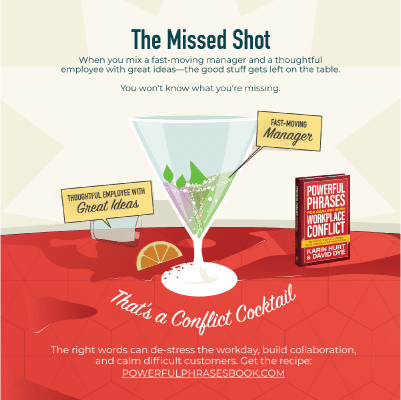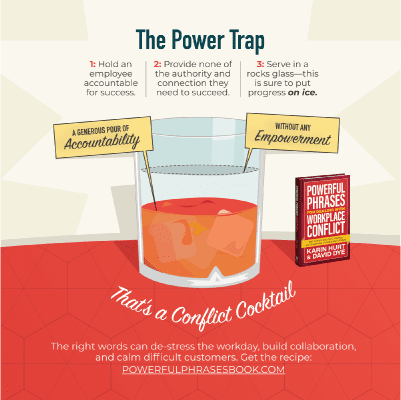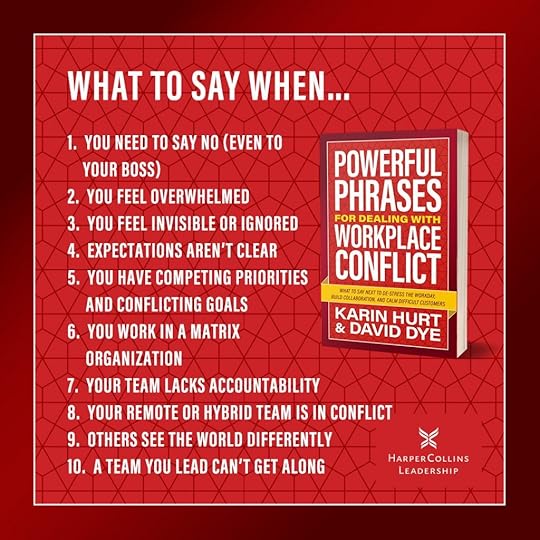David Dye's Blog, page 14
November 4, 2024
How to Lead Sustainable Business Culture Change: A 3-Step Framework for Success
Think about the business culture you’ve always wanted for your organization—the energy, the purpose, the unwavering alignment toward a common vision. Now, think about how much easier it would be if every team member, from the boardroom to the front lines, shared that same drive and commitment. Imagine a workplace where people aren’t just showing up for a job fully invest in a shared purpose that pushes your organization forward every single day.
This kind of culture doesn’t happen by accident. It requires intentional, visible leadership and a clear, consistent message that speaks louder than words. There are three critical steps senior leaders must take to make this vision a reality:
Visibly ModelComprehensively CommunicateIntentionally AmplifyLasting Business Culture Change Starts with Senior LeadersOur favorite definition of culture comes from marketing guru Seth Godin. Culture is simply “People like us, do things like this.”
But one of the major culture challenges organizations face is that senior leaders might know what activities and habits matter most. But those same leaders struggle to communicate that knowledge and transfer behaviors throughout the organization.
True culture change requires your deliberate action, consistent messaging, and intentional reinforcement at every level. As a senior leader, your commitment to modeling, communicating, and reinforcing the culture sets the tone for lasting change.
1. Visibly ModelWhat you do matters way more than what you say.
Every decision you make, every action you take, tells your people what’s truly important in the organization. To drive culture change, you must align your actions with the business culture you want to create.
And it’s not just how you act when you’re with your peers. Or how you reason through a decision.
How can the entire organization visibly see you act out the culture you want?
What you do matters way more than what you say.
Here’s a quick gut check: If a new employee, with no training or handbook, watched a film of all your activities for a couple of weeks, how would they describe your culture?
Here are three examples of how you might align your visible actions with your business culture:
Decision-Making Transparency: Making a sound decision isn’t enough to change culture. Everyone needs to understand the reasons for the decision. Be clear about why you make the decisions you do. Explain not only the “what” but the “why” behind strategic choices. This transparency shows your team the values that guide decision-making. And it will help them make similar decisions in the future.
Prioritizing People in Meetings and Conversations: If you want a culture where people feel valued and heard, demonstrate this by giving people your full attention. Put away your phone. Show them that every voice matters by actively listening and encouraging contributions.
Living the Company Values: Identify three behaviors tied to your organization’s core values and commit to visibly demonstrate them each week. For example, if “innovation” is a core value, consider how you can visibly invite new ideas, tolerate a reasonable level of risk in pursuit of innovation, and respond with regard—even when you can’t use an idea.
When your team sees you model the change, they’ll begin to believe in its importance. A cultural shift won’t happen until everyone can see it—and that starts with you.
2. Comprehensively CommunicateOnce you’re visibly modeling the desired business culture, the next step is to communicate throughout the organization. This is where a 5 x 5 communication plan is essential. How will you and your managers communicate at least five times, through five different channels?
Your communication strategy should build a culture where everyone:
Understands the ‘why’ behind the changeClearly sees how it relates to their role.The more you communicate—and the more you empower others to communicate—the more natural the change will feel.
Here are questions to consider as you build your communication strategy:
How will you connect what you are asking to why it matters – in a way that makes sense to every person in every role?How will you ensure that your teams communicate the new business culture habits with fidelity? (How will they cascade communication? And how can you ensure they know how?)What are one or two strategic stories you can include in your communication to bring the habits to life? (For example: share a time you struggled with the tension between two values and how you made your decision.)How else might you get creative and have fun with communicating your culture, values, and relevant habits? (Check out this list of 101 ways to communicate–even with hybrid and remote teams.)How can you engage everyone in the organization to make the culture their own? To ask questions and explore or challenge areas that don’t make sense to them?3. Intentionally Amplify with Celebration and AccountabilityEveryone can see you and your team model the culture. You’ve clearly communicated and engaged everyone to understand what the change looks like in every role.
Now it’s time to build momentum with celebration and accountability.
Celebration and accountability are two sides of the same coin. They both close the loop of an intention. You set out to do something.
When you succeed, celebrate!
When you don’t, follow through with accountability: what can you learn for next time? What needs to change? Is there a way to renew the commitment and follow through now?
Celebration and accountability amplify your business culture. They tell everyone what matters. So don’t leave them to chance. Plan your celebration and accountability strategy from the start.
Celebrate Early Wins and Small StepsAs soon as you see behaviors that reflect the new culture, acknowledge them. Whether it’s a team reaching a milestone or an individual embodying the values, celebrate the moment. Tell these stories. Highlighting these achievements reminds everyone that the change isn’t just words on a wall. Change is real and happening.
Set Clear Expectations for AccountabilityHold yourself and other leaders accountable for embodying the culture. Equip everyone to give feedback—even junior employees should feel empowered to respectfully hold senior leaders accountable. This shows that the new culture applies to everyone, regardless of role.
Continual Reflection and AdjustmentCulture change isn’t a one-time project; it’s an ongoing commitment. Regularly evaluate the progress and adjust as needed. Have a quarterly or semi-annual culture review where you discuss what’s working, what needs adjustment, and what new behaviors need reinforcement.
Celebration and accountability go hand in hand. When you make a big deal out of the behaviors you want to see and create space for accountability, you’re building a self-sustaining culture where people take pride in maintaining the values and behaviors you’ve established.
Want a Blueprint for Your Culture Change?Sustained business culture change requires intentional effort.
One of our favorite things is to work with senior teams to build your leadership blueprint. Together, you’ll identify the specific habits that will help you model, communicate, and amplify your culture and achieve breakthrough results.
Let us know if you’d like more information.
The post How to Lead Sustainable Business Culture Change: A 3-Step Framework for Success appeared first on Let's Grow Leaders.
November 1, 2024
How do I Succeed in My First Job? Asking for a Friend
You’re new to your career. Maybe this is even your very first job. You want to get it right and have smooth sailing from the start. Excellent. Let’s start with three practical tips that make your new career easier. Oh, yeah, and this advice works great for your second, third, and thirteenth job too 😉

This Powerful Phrase works wonders with your manager, your co-workers, your customers, and other key stakeholders.
I can’t think of anyone who doesn’t want to hear these words said sincerely, from someone with a reputation of following through.
“How can I be most helpful.”
Whether this is your first job, or you’re looking to enhance your reputation in a role you’ve been in for a while, showing up genuinely supportive and ready to help is like a fast pass to a great reputation. (Of course, asking is the first step. Next, you need to act on what you hear. Find a way to be helpful in the areas others care most about.
step. Next, you need to act on what you hear. Find a way to be helpful in the areas others care most about.
As you begin your first job, you want to show that you’re not just a hard worker, but someone who gets the big picture and spends time working on the most important things.
Of course, tone of voice matters.
“Why are we doing this,” said sarcastically won’t do your new career any favors. But asking genuinely curious questions about the bigger picture, or checking for understanding about how the work you’re doing will be used, opens the door for you to share ideas and contribute at a deeper level.
3 Invest in building relationships through better communicationOur new book Powerful Phrases for Dealing with Workplace Conflict: What to Say Next to De-Stress the Workday, Build Collaboration and Calm Difficult Customers gives you practical, tactical ways to do this well– starting with four dimensions of collaboration: connection, clarity, curiosity and commitment– and powerful phrases for when your new job starts to go sideways.
More Articles You Might Find Helpful As You Start Your New JobWant More Influence at Work? Avoid These Communication Mistakes
How Your Great Boss Might Be Hurting Your Career
How to Give Your Boss Bad News
Fuel Your Career: 17 Critical Skills When You’re a Young Leader Hungry For Success
The post How do I Succeed in My First Job? Asking for a Friend appeared first on Let's Grow Leaders.
Unlocking Creativity: How to Cultivate a Fun Work Culture
Are your employees enjoying their work—or just going through the motions? What if a fun work culture could boost both morale and performance?
In this episode, leadership expert Phil Geldart shares how bringing genuine, meaningful fun into the workplace can transform team dynamics, engagement, and productivity. For leaders facing resistance or a need for change, this episode offers actionable insights to create a more engaging and motivated environment.
Listen in to discover:
Practical ways to incorporate fun that enhances learning and productivity.The four essential steps to inspire lasting behavioral change in the workplace.How respecting employees as adults can unlock higher performance and genuine enjoyment.Don’t wait—hit play now to start building a workplace where people truly enjoy bringing their best selves to work!
Building a Fun Work Culture: Lessons and Strategies00:00 – 01:12 | Recognizing Resistance to Change
Phil discusses how employees often resist change, especially if they’re used to certain routines or leadership styles. This reluctance isn’t malicious—it’s human nature. Discover why a fun work culture can play a key role in encouraging openness to change.
02:52 – 04:05 | Early Lessons in Leadership
Phil recalls his first leadership experience as a camp counselor, where he learned the value of making tasks enjoyable. By turning activities into games, he discovered the power of a fun work culture to engage and motivate his group.
10:49 – 12:11 | Experiential Learning as a Pathway to Growth
In this memorable story, Phil explains how using games in training can bridge the gap between theory and practice, leading to genuine learning and engagement. His approach to building a fun work culture has helped organizations boost team performance and morale.
13:55 – 14:56 | Results-Driven Fun
Phil connects the dots between fun at work and achieving results. He emphasizes that creating a fun work culture doesn’t mean ignoring outcomes—instead, it aligns people’s natural motivations with the company’s goals, fostering both enjoyment and accountability.
20:51 – 22:30 | Avoiding the “Cringe” Factor in Fun
David and Phil discuss the difference between genuine fun and forced “cringe” activities. Here, Phil shares insights on creating an authentic work culture that aligns with employees’ true interests rather than relying on artificial or obligatory activities.
22:30 – 24:21 | Simple Exercise for Leadership Growth
Phil introduces a powerful tool for leaders: ask your team, “What do I need to do to be a better leader?” This question builds trust and creates a foundation for a fun work culture by showing employees that their voices matter.
32:21 – 33:40 | Genuine Friendliness as a Value
In his own company, Phil has embraced “genuine friendliness” as a core value, emphasizing that a truly fun work culture starts with leaders who respect and care about their employees as individuals.
35:08 – 36:36 | Overcoming Barriers to Fun at Work
Phil shares a story of a CEO who misunderstood laughter in the break room as a lack of seriousness. This anecdote highlights common barriers to a fun work culture and underscores the importance of leadership self-awareness.
41:13 – 42:18 | The Impact of Caring Leaders
Phil recounts an experience with a former boss who canceled his entire afternoon to discuss Phil’s career goals. This genuine care and attention helped shape Phil’s approach to leadership and fostered a lasting commitment to building a fun work culture.
45:30 – 46:56 | How Leaders Can Build Trust and Engagement
Phil explains that a fun work culture requires leaders to respect employees as adults and encourage authentic engagement. He advises leaders to reflect on whether they’re creating an environment where people feel valued and excited to contribute.
The post Unlocking Creativity: How to Cultivate a Fun Work Culture appeared first on Let's Grow Leaders.
October 28, 2024
Career Advice: How to Advocate for Yourself at Work
When I’m keynoting conferences, there’s always a long line at the book-signing table or cocktail reception with people eager for career advice. One of the most common questions I receive is, “How do I advocate for myself and ask for what I need? A raise? A promotion? A bigger project?”
And I always ask, “Well, what have you tried so far?”
Here’s where things often take a wrong turn. Inevitably, they’ve got it backward.
They’re advocating from their point of view.
I hear things like, “I’ve worked so hard,” or “I’ve been here for years,” or “I need that raise—I’ve got bills, and my significant other said I should’ve gotten this by now.”
And while all of that might be true (and important to you), it’s not what decision-makers are thinking about when figuring out whether to give you that promotion, raise, or opportunity.
Here’s how I discovered this career advice the hard way (don’t worry, it has a happy ending).I had just been promoted to my very first executive role at Verizon. My new boss was from the other side of the merger.
I hadn’t even started the new role when the union went on strike. Instead of starting my exciting new dream job, I would sub in for the union as a directory assistance operator for God knows how long (could be weeks, months, or even years). Twelve hours a day (plus a 2-hour commute), 7 days a week.
But that’s not the tricky part.
The tricky part was that I had just separated from my husband and we had a wonderful little boy who was confused and scared about now “living in two houses.” But, there was no way he could live in my house during this time because I was answering telephones night and day.
I felt guilty, sad, exhausted, and wondering if this whole mess was worth it. Maybe I should just quit….the only thing that kept me going was knowing that my dream job was on the other side of this strike if I could stick it out.
One Tuesday night, my strike-duty supervisor, tapped me on the shoulder and told me I had an emergency call, and to take it in her office. Just what every guilty, sad, exhausted mom wants to hear.
It was my new boss. “Karin, this is Gail (your new boss).” We had never met.
“I’m calling to tell you that due to the expenses of the strike we’ve decided to eliminate a few positions. I can only have three executives on my team and we announced four. So since this is a promotion for you, and everyone else is already a director, we’re moving you back to your old position. Don’t worry. I’m sure you will be promoted at another time.”
My heart sank.
And, I’m not sure how I knew to do this, but I instinctively advocated for myself from the decision-maker’s point of view.
First I connected with empathy.
“Gail, Thank you for calling me personally. I’m looking forward to working with you. I’ve heard great things about your leadership. I understand how complicated this is, and how difficult it must be to make this call.”
And then I spoke her language.
“I know this is a new role for you too and you’ve got a heavy lift ahead of you with all this merger integration work. You’re going to need a rock star team. I’m curious, are the seasoned directors all box 9 succession planning candidates (that’s HR speak for are they all “rock stars”?
She said, “Well, no…. not exactly, but they are very experienced.”
“What competencies are going to be vital on this team?” (More decision-maker language… HR folks love to talk competencies 😉
She listed the most important competencies: strategic vision and thinking; working as a trusted strategic partner with the executive team; executing with urgency.
“I’ve got those. All I ask before you make this decision is you call these three very senior executives (gave her three names) and ask them about how I’ve demonstrated these competencies in my HR work supporting their teams, and whether they think I’m the right choice over one of your more seasoned candidates.”
“Okay, I’ll do that.”
(Then I hung up the phone and burst into tears– but Gail didn’t see that part).
Gail did call those executives. I got the job.
And Gail become a lifelong mentor and career advocate. For more on Gail see: When Things Get Crazy Look for Ways to Empower Your Team
How to Advocate for Yourself From the Decision Maker’s Point of ViewNo one had every given me this career advice. And quite frankly, I was desperate. I wanted to scream, “Do you know what this company is doing to my life right now?” But that didn’t feel very executive.
Let’s break this down so you can advocate for yourself too.
1. Connect with Empathy and Consider Their WorldWhen you ask for a promotion or raise, position your request in terms of how it benefits your boss, your team, and the company. The person making the decision isn’t just thinking about you—they’re thinking about how your request impacts the bigger picture.
Instead of “I’ve worked hard for three years,” or “Do you understand the sacrifices I’ve made for this company, reframe it like this:
“In my three years here, I’ve improved efficiency by 20% on my team, which has led to a significant cost savings of $X. I’m excited about taking that same approach to a broader scope of work, which will continue to improve our bottom line.”
See the difference? You’re not just listing why you deserve the promotion, but how promoting you helps them reach their goals.
2. Speak Their LanguageIn this case, I understood how these decisions were made. I’d built over a hundred competency models and helped leaders use those to select candidates (and eliminate positions). I wanted her to know I got her world.
got her world.
If you’re advocating for a raise, don’t just talk about how much you need it. Decision-makers aren’t moved by your rent, student loans, or the vacation you’re planning. They want to know why you’re worth it.
Think about how your role impacts what your decision-maker cares about—whether that’s profit, customer retention, innovation, or team performance. Then, use that language.
“Over the last year, I’ve helped retain 95% of our clients, which translates to $X in repeat business. Given these results, I believe my contribution aligns with a higher level of compensation.”
Now, you’re speaking their language. You’re connecting the dots between your work and their priorities.
3. Consider your TimingIn my case, I had one shot at my pitch.
But sometimes you get to choose your timing.
If you ask for a raise or promotion in the middle of a crises, you will lose credibility. “How can they be concerned about their career, when the S#$*#@ is hitting the fan in so many ways?
Advocating for yourself also means knowing when to push and when to wait.
4. Own the OutcomeSometimes you’ll do everything right and still get a “no.”
But that doesn’t mean it’s over. This is where you have a chance to shine even brighter. Respond with grace and ask for feedback. What would make you an even stronger candidate next time? What’s the timeline for future opportunities? Stay curious and proactive. You’re showing you’re serious, resilient, and forward-thinking.
And here’s the kicker: Sometimes just handling the “no” with confidence and professionalism puts you top of mind for the next opportunity.
See Also: How to Not Screw Up Your Brand When You’ve Been Screwed Over
And How to Improve Your Professional Brand at Work
Advocating for yourself is essential. But the trick isn’t just making a list of why you deserve it. Flip the script. Think about the decision-maker’s priorities, speak their language, and tie your success to theirs.
When you make it easy for them to say yes, you’re closer to the raise, promotion, or opportunity you’ve been working toward.
So, next time you’re ready to ask for what you need, follow this career advice. Don’t just think about what you want—think about what they want.
Your turn.
What’s your best career advice when someone needs to ask for what they need? How do you advocate for yourself from the decision maker’s point of view?
The post Career Advice: How to Advocate for Yourself at Work appeared first on Let's Grow Leaders.
October 25, 2024
How to Make the Most of A Professional Development Conference
at Your Next Professional Development Conference
You’re attending an industry conference or professional development event, and are fired up with ALL THE IDEAS. You want to do all the ideas right away.
And you know that doing everything, everywhere, all at once isn’t realistic.
So what should you do? How do you take action and get the best ROI without overwhelming yourself, your team, or worse of all, not doing anything?
Here’s one tip that works wonders: A mini-personal experiment.

Learn more about mini-personal experiments in our book, Courageous Cultures: How to Build Teams of Micro-Innovators, Problem Solvers and Customer Advocates.
How to do a mini-personal experimentPick one practical, measurable change in your approach (it could be a habit, a new process or a technique), that meets these criteria:
1. DOABLE. You can make a difference within 30 days (daily habits work best)
2. VALUABLE. This new habit, process, or technique would add significant value (e.g. to your results, to your team, to your well being)
3. MEASURABLE. You will be able to measure how it worked.
Then make a plan.
What’s the experiment, what will you do, how will you measure? Bonus networking points if you find an accountability partner you did not know before and schedule a 15 and 30-day check-in to talk about how it’s going.
Your turn. 
I would love to hear from you. How do you get the most out of a professional development conference?
Are you looking for a speaker for your next professional development conference, company offside, or industry event? I’d love to talk about how I can bring a highly interactive keynote or deep dive workshop to your event. Click on the image to the right to watch my new speaking reel,
The post How to Make the Most of A Professional Development Conference appeared first on Let's Grow Leaders.
How to Make the Most of A Professsional Development Conference
at Your Next Professional Development Conference
You’re attending an industry conference or professional development event, and are fired up with ALL THE IDEAS. You want to do all the ideas right away.
And you know that doing everything, everywhere, all at once isn’t realistic.
So what should you do? How do you take action and get the best ROI without overwhelming yourself, your team, or worse of all, not doing anything?
Here’s one tip that works wonders: A mini-personal experiment.

Learn more about mini-personal experiments in our book, Courageous Cultures: How to Build Teams of Micro-Innovators, Problem Solvers and Customer Advocates.
How to do a mini-personal experimentPick one practical, measurable change in your approach (it could be a habit, a new process or a technique), that meets these criteria:
1. DOABLE. You can make a difference within 30 days (daily habits work best)
2. VALUABLE. This new habit, process, or technique would add significant value (e.g. to your results, to your team, to your well being)
3. MEASURABLE. You will be able to measure how it worked.
Then make a plan.
What’s the experiment, what will you do, how will you measure? Bonus networking points if you find an accountability partner you did not know before and schedule a 15 and 30-day check-in to talk about how it’s going.
Your turn. 
I would love to hear from you. How do you get the most out of a professional development conference?
Are you looking for a speaker for your next professional development conference, company offside, or industry event? I’d love to talk about how I can bring a highly interactive keynote or deep dive workshop to your event. Click on the image to the right to watch my new speaking reel,
The post How to Make the Most of A Professsional Development Conference appeared first on Let's Grow Leaders.
3 Vital Questions You Must Answer to Manage Up Effectively
Episode 276: Do you ever feel like your attempts to manage up leave your manager more frustrated than satisfied? If you’ve answered their question without adding your perspective, you might miss a key opportunity to increase your influence and reduce their stress.
As a leader, your ability to communicate effectively directly impacts your success and your team’s performance. In this episode, we dive into leaders’ four common mistakes when managing up and how these simple missteps can lead to frustration, missed opportunities, and micromanagement.
Listen to this episode to:
Discover the three critical questions to help you build trust, save time, and increase your influence with your manager.Learn practical strategies to present information that adds value instead of confusion.Understand how to align your communication style with your manager’s needs to avoid miscommunication and frustration.Ready to transform your communication with your manager? Press play now and learn how to master influencing your boss for better results and less stress!
Common Mistakes When Managing Up[00:00] – Kicking off the episode with a key insight: when your manager asks for information, don’t just answer the question—influence them more effectively by offering your perspective and adding value.
[01:27] – Learn about the four most common mistakes people make when they manage up, including misinterpreting your manager’s ask and overloading them with unnecessary data.
[02:40] – Mistake #1: Misinterpreting the ask. When you’re moving fast, it’s easy to focus on the details and miss the bigger picture that your manager actually needs.
[03:49] – Mistake #2: Assuming your boss thinks like you. Different communication and decision-making styles can create a disconnect if you don’t communicate with their preferences in mind.
[04:39] – Mistake #3: Trying to stay out of trouble by overloading your boss with information or avoiding recommendations out of fear of their reaction.
Questions to Ask[05:32] – Discover three critical questions to answer if you want to manage up effectively: What does your manager need, how do they need it, and when do they need it?
[06:22] – Start by asking, “What does my manager really need?”—this will help you provide valuable insights rather than just raw data or surface-level answers.
[07:14] – Think ahead: What are the next three questions your manager might ask? Managing up means being proactive and anticipating their needs before they have to ask.
[09:30]—Understand how your boss prefers to receive information, whether through written reports, visuals, or verbal discussions. Effectively influencing your boss requires adapting to their style.
Mastering the Art of Influencing Your Boss[11:44] – Schedule the finish. Managing up isn’t just about providing information—it’s also about setting clear deadlines and resolving competing priorities to efficiently meet your boss’s expectations.
The post 3 Vital Questions You Must Answer to Manage Up Effectively appeared first on Let's Grow Leaders.
October 21, 2024
Shaken, Not Stirred: 4 Examples of Workplace Conflict and How to Build Stronger Bonds
Powerful Phrases That Turn Conflict Cocktails into Care-Filled Collaboration
If it feels like you’re experiencing more conflict at work over the last few years, you’re in good company. Our research shows that not only is conflict more frequent, but it’s also getting more challenging to navigate. Today’s examples of workplace conflict can best be described as a complex cocktail of challenges: tired workers in an uncertain economy; a pandemic hangover of isolation and anxiety; rapid social and technological change; and exhausted managers doing the best they can– many of whom lack the training and resources to navigate this well.
4 Examples of Workplace Conflict (And What to Say Next)This guide is your recipe book, offering you a few Powerful phrases and strategies needed to craft the perfect chaser to the biggest examples of workplace conflict. So, cheers to you as we give you some starter words to navigate these conflict cocktails.
 The Conflict Cocktail: The Wedge Driver
The Conflict Cocktail: The Wedge DriverThe pandemic sped up changes in the workforce. More than ever before, people want meaning in their work. And, work itself is changing fast. The World Workplace Conflict and Collaboration results citing continued overwhelm, economic instability, lower levels of motivation, and poor management are symptoms of this upheaval.
Larger organizations have people scattered across seven different time zones. In a world of remote work, many of these people have never met each other in person.
Most managers don’t have formal training on how to deal with such issues (27% of the respondents in our research attribute the increase in conflict to poor management practices).
If you’re in a matrixed organization, it gets more complicated. Lines of responsibility can be fuzzy, and your priorities or incentives might clash with your coworkers’ goals. But you need your coworkers’ help to succeed at your job.
That’s a conflict cocktail.
What to Say Next(See Chapters 9 and 11 of Powerful Phrases for Dealing with Workplace Conflict: What to Say When You’re Overwhelmed and What to Say When Expectations Aren’t Clear)
This is one of the trickiest examples of workplace conflict, but there is hope. The antidote to uncertainty is clarity, so start by aligning around a vision of success.
“What would a successful outcome DO for you.”You may or may not agree on what success looks like, but when you’re dealing with a remote workforce dealing with lots of change, gaining clarity around expectations can save a lot of time and wasted energy. This powerful question also gives you insights into deeper motives and unspoken expectations.
Andi, if expectations are unclear, or there are differences of opinion about how to handle a situation, you can try this combination of Powerful Phrases.
“It seems that we see this differently.”Rapid change and new technology can often lead to unclear norms. How do we use AI? And, how do we check the facts? What communication channels are appropriate for what messages? Should cameras always be on in team meetings? What about customer conversations? One-on-ones?
“Here’s the challenge we face..“And then describe the consequences if the lack of clarity continues. For example, “There’s no rule about this, so it’s up to us to figure it out. The challenge we face if we don’t agree on how we …. (use cameras in meetings, include people in radically different time zones on decisions, communicate sensitive information when we can’t look each other in the eye). So it’s up to us to figure it out. The challenge we face if we don’t agree on how we use cameras is that we’ll all feel resentful, disrespected, and exhausted.”
It’s also helpful to empower every member of your team with words to say when they’re feeling overwhelmed. Here are a few of our favorites to deal with such examples of workplace conflict.
“If I had to drop a ball here, which one should that be?”and simply, “I could use some help.” The Missed Shot
The Missed ShotSee chapters 10 (I feel visible or ignored), 23 (boss doesn’t see my genius), and 26 (know it alls)
The missed shot happens when you combine a fast-moving manager with a thoughtful employee with innovative thoughts they’re keeping to themselves because they don’t want to slow things down or appear negative.
What’s left behind? Potentially revolutionary ideas or vital micro-innovations – unspoken, unexplored, overshadowed by the urgency of immediate tasks.
This ‘missed shot’ phenomenon is not just a communication gap; it’s a significant loss for organizational innovation.
The most transformative ideas often emerge from those who take time to think deeply, analyze thoroughly, and speak after careful consideration. When these ideas are overlooked, you miss out on opportunities for big ideas and smaller micro-innovations that would make work, work better.
What to Say NextSo how do navigate this conflict cocktail?
If you’re a manager, be deliberate in your ask. This is more than an open door.
Ask specific courageous questions such as:
“What’s one thing we’re missing in this process?”Or…
“What’s your biggest concern about the plan we’ve laid out?”And if you’re the one with the overlooked ideas, you won’t want to miss chapter 10 (on feeling invisible and ignored) and chapter 23 (doesn’t appreciate you or see your genius).
“I have an idea that will ______ (insert strategic benefit statement here).”A strong benefit statement in the first sentence is the best way to slow down a well-meaning, fast-moving manager.“I know you haven’t had much opportunity to see my ability to ______. What if I took on _____ (a special project, a pilot of an idea).” The Power Trap
The Power TrapSeveral chapters from Powerful Phrases for Dealing with Workplace Conflict work well here (Chapter 13, Matrix Organization; Chapter 18, Micro-Manager, Chapter 20, Boss Won’t Make a Decision,
Has this ever happened to you? You’re on the hook for results, and you want to achieve them. But there’s a catch. You’re not empowered to make the decisions you need to be successful.
Or maybe you work in a matrix environment where every decision requires consensus. Or you’re in a customer-facing role, held accountable for NPS (net promoter score), but your hands are tied to make even small “common sense” choices to delight a customer without placing them on hold to escalate the issue.
Twenty-seven percent of respondents who said they’re experiencing more or significantly more workplace conflict in the last few years said it was due to “poor management practices.” This example of workplace conflict- Accountability without empowerment is certainly one aspect.
So how do you navigate this conflict cocktail?
A few Powerful Phrases can be helpful here… framing your conversations in four dimensions of productive conflict: Connection, Clarity, Curiosity and Commitment.
What to Say Next “I’m fully committed to our shared goals (CONNECTION) and am seeking ways to enhance our efficiency. Could we discuss expanding my decision-making authority to streamline our processes” (CLARITY)?”By starting with a connection to the relationship and the outcomes, you open the door for solutions. And then, you follow up with a specific ask. Be sure to be prepared with specific suggestions.
“Our matrix structure has its strengths, but I believe we can improve our response time (CLARITY). What are your thoughts on creating a fast-track decision path for certain operational decisions” (CURIOSITY)?With this Powerful Phrase, you’re starting from a positive frame of mind and inviting others to be part of the solution. The Blown Fuse
The Blown FuseThis is one of the hottest trending examples of workplace conflicts, tensions between exhausted workers and strung-out customers.
Since the COVID-19 pandemic, many industries have found it more challenging than ever to attract and keep talent. Employees in the education, healthcare, service, and hospitality industries say they’re sick and tired of rude and hostile customers, students, and patients, grueling hours, and impossible demands.
And customers complain about long waits, poor service apathetic staff, and tip creep.
What to Say NextYour connection G.O.A.T.s (Greatest of all Time) Powerful Phrases and habits are vital in these complex examples of workplace conflict, and you won’t want to miss chapter 32 on dealing with difficult customers.
First, the connection G.O.A.T.s
“I care about ______ (you, your experience, your concern), and I’m confident we can find a solution we can all work with.”Acknowledge the challenge, your difference of opinions, and your confidence that you can work through it together.
“Tell me more.”Nothing builds connection more than being seen, and this Powerful Phrase gets there in just three words.
“It sounds like you’re feeling __________ is that right? (pause for affirmation. And that you for letting me know how you feel. ”
This Powerful Phrase is a tried-and-true relationship-building technique called “reflect to connect.” When you “reflect to connect” you’re not agreeing with what they’ve said or telling them you agree with their emotion. Rather you’re acknowledging how they feel You see them. When you reflect, you create a common starting place for the conversation.
And now a few for dealing with difficult customers.
“I’m so sorry this happened to you. Let’s fix this right now.”A good start is always “I’m sorry,” and acknowledging their concern or emotions.
“I know exactly what we need to do next and I’m on it. I’m not letting you go until we get this resolved.”Building the customer’s confidence in the first forty seconds of the interaction is another great way to calm a concerned customer. This Powerful Phrase infuses confidence into the conversation and reassures the customer that you care.
Becoming a Master Mixologist.As you stir through the pages of this guide, armed now with an arsenal of powerful phrases to transform conflict cocktails into concoctions of care-filled collaboration, remember: every workplace conflict, like a complex cocktail, is a blend of diverse ingredients. The Wedge Driver, the Missed Shot, the Power Trap, the Blown Fuse—each presents its own flavor of challenge, yet also, a unique opportunity for growth and understanding.
So, as you go back to your workplace, shaker in hand, ready to address the next conflict cocktail that comes your way, remember that the secret ingredient is always your approach. Each conversation, each interaction, is your opportunity to mix, to taste, and to refine. It’s in these moments that care-filled collaboration is distilled, leaving behind the sediment of misunderstanding and isolation.
The post Shaken, Not Stirred: 4 Examples of Workplace Conflict and How to Build Stronger Bonds appeared first on Let's Grow Leaders.
October 18, 2024
How to Deal with Team Conflict and Get Everyone Back to Work
You’ve got a clear focus on what matters most. Your team seems to work well together, but then you get that call: “I need to talk to you about …” or a team member suddenly explodes at their teammates and storms off the floor. It’s conflict, a disagreement, or a clash of personalities. Handle it well and you’ll build trust and influence. But ignore it or respond poorly and not only do you lose trust and credibility, but the conflict distracts your team from the work that matters most. Team conflict can feel like quicksand and a distraction from your work, but it’s an excellent opportunity to improve morale, productivity, and processes.
8 Ways to Deal with Team ConflictHire for Conflict Communication SkillsDe-escalate Heated Conflict in the MomentReflect to ConnectGather Information with Three Quick QuestionsDiagnose the Situation: Is this a vent or a problem that needs to be solved?[For Problems:] Discuss and Choose an Appropriate SolutionSchedule the FinishBonus: Equip Your Team with Powerful Phrases to Resolve Conflict TogetherTeam Conflict is UnavoidableEarly in my (David’s) career, my boss Jim, the Executive Vice President, took me to lunch at a popular spot for business meetings with a bustling dining room. Apparently, he’d seen me struggling with a common problem new leaders face and chose this lunch to deliver some coaching.
As we waited for our food to arrive, I got up to wash my hands. Jim stopped me for a moment and gave me an assignment: “Take the long way through the restaurant to and from the washroom. Walk slowly and catch the bits of conversation you hear.”
I followed his strange instructions and when I returned to the table, Jim said, “Of the conversations you heard, how many of them were complaining–about their boss, a co-worker, or a problem at work?”
“Half or more, from what I heard,” I answered.
He nodded. “And that’s normal. It’s human nature to complain. You can’t respond to every complaint you hear. Not every complaint needs a solution. And complaints don’t necessarily mean anything’s wrong.”
It was an important lesson for a young leader: conflict between people is unavoidable. But there’s always a leadership opportunity when a team member brings you a complaint. Depending on the circumstance, it may be an opportunity for that person to grow, for you to improve your leadership, or a moment to connect, build a stronger team, or a better process.
How to Address Team Conflict ProductivelyHere are eight steps you can take to address conflict effectively, build healthy professional relationships, and help your team maintain their focus on what matters most.
1. Hire for Conflict Communication SkillsAs a leader, you have two choices to build teams that are good at conflict resolution: either hire for the skills or teach the skills.
What doesn’t work is expecting people to have skills you haven’t specifically checked out or taught them. And the fastest way to build a team that’s good at conflict is to hire for those skills. You can do this with a few behavior-based interview questions. For example:
“Tell me about a time when…”
“A coworker seriously irritated you. What happened? What did you do? What was the outcome?”“You radically disagreed with your manager. How did you handle that?”“You weren’t able to do your work correctly because of someone else’s behavior. How did you address the situation?”While many people will describe how they stayed silent, kept their head down, or got frustrated and left, you’re looking for the candidates who spoke up and shared their concerns elegantly.
2. De-escalate Heated Team Conflict in the MomentA quarrel between teammates escalates into a shouting match. Seemingly out of nowhere, an employee swears, slams a door, and storms into the breakroom or parking lot.
Many managers respond to these heated moments by getting sucked into the drama or trying to ignore it altogether. But either way, the situation won’t improve.
When tempers flare, your first job is to re-establish a safe working environment for the entire team. That means taking a breath and making sure you are calm, centered, and don’t react to the drama. Next, if the people involved are still in a public area or with the rest of the team, move the people involved to a more private space where you can talk.
Rather than talking right away about their unprofessional behavior, begin the conversation by getting the facts. Ask “What happened?”
As you hear their side, check for understanding: “So what I hear you saying is that there were too many people in your space and you couldn’t get your work done. Do I have that right?”
If the person is distraught and says things like, “You don’t understand!” You can help de-escalate the conversation by calmly and quietly saying, “You’re right. I don’t understand. And I’d like to. Can you tell me what happened?”
As you confirm the facts, you can also de-escalate the situation by acknowledging and checking on feelings. For example, “It sounds like having all those people in your space was very frustrating?” (More on this in #3 below).
Once you’ve heard the other person’s perspective and acknowledged their feelings, you can guide the discussion to solutions. This depends on the specific circumstances, what happened, and if they can safely return to their work. An apology might be in order, along with some coaching to help them deal with their frustrations productively. The next steps can help you know what direction to go.
3. Reflect to ConnectWhen a team member comes to you with a frustration, complaint, or problem, (even if it’s not an explosive situation) the most effective thing you can do to build a productive conversation is to acknowledge their emotion. When they know you’ve heard them, it diffuses some of the emotional intensity and builds a connection that allows you to move to constructive next steps.
We call this process of acknowledging emotion “reflect to connect” because you are reflecting the emotion you observed and making sure you understand what’s on their mind.
For example: “It sounds like you’re really frustrated with the lack of response from marketing and that’s sapping your motivation. Do I have that right?”
Note: you’re not telling them that their feelings are right or wrong. When you reflect, you are checking for understanding and creating a common starting place for the conversation.
4. Gather Information with Three Quick QuestionsOnce you’ve acknowledged the person’s feelings, your next step is to get more information. Your actions going forward depend on the specific circumstances so it’s vital to know what’s happening. There are three questions you can ask to quickly assess the situation:
What do you want me to know?—We learned this question from trial attorney Heather Hansen. It’s a fantastic question to help draw out what is most meaningful to the person who brought you the issue.How might I help here?—The power of this question is that it quickly reveals whether the other person just wants to blow off steam or has a problem. It also gives you insight into how they perceive the problem.Should the three (or more) of us talk together?—This question is helpful in those situations where you suspect the person might have a motivation other than solving the problem (like undermining a colleague or currying favor). For people who complain and want to dump their problems on you, it helps maintain mutual responsibility.5. Diagnose the Situation: Is this a vent or a problem that needs to be solved?After you ask these three questions, you will likely have enough information to diagnose the situation. Here are some of the most common types of team conflict to look for:
The person just needs to vent and get a frustration off their chest.There’s a misunderstanding.One party is unresponsive or sees priorities differently.People are working toward different goals.There’s a style or personality conflict.You discover toxic behavior.There are structural issues with a process or systems causing the conflict.6. [For Problems:] Discuss and Choose an Appropriate SolutionIf the person doesn’t need any action and just needed to blow off steam, your reflect-to-connect will likely be all they need to get back to work. For problems, however, the solution will depend on the specific situation. Here are a few examples:
If you identify a misunderstanding, equipping the person to have the discussion and clarify what’s happening might be appropriate.Sometimes you’ll find that you caused the problem. Perhaps your statement of goals is unclear or you haven’t clarified how values should resolve when in conflict. In these cases, your best path forward is to convene the interested parties and give them the clarity they need.For other cases of unresponsive peers, personality or style conflicts, or other situations where a discussion will help, you may bring the people together and discuss the situation and come to a mutual understanding of the way forward.When you discover toxic or abusive behavior, you and/or your HR team may formally intervene.When you uncover structural issues, fix them if you can. If you can’t take immediate action yourself, let your team know how you will advocate for them and help them work through the specific challenge.7. Schedule the FinishWhatever the next steps you and the people involved agree on, be sure to schedule a time in the future when you will all review what happened and ensure that everyone followed through on their commitments and responsibilities. Scheduling the finish ensures that you won’t repeatedly have to revisit this same team conflict.
8. Bonus: Equip Your Team with Powerful Phrases to Resolve Conflict Together
Click here for FREE Sample Chapters
One of the most effective ways you can help your team to resolve conflict is to give them the tools to have meaningful conversations with one another and the expectation that they will use them. The highest-performing teams don’t shy away from conflict. They embrace it and understand that every disagreement is an opportunity to build relationships and improve results.
When there’s a lack of clarity, help your team ask questions of one another, like:
“What would a successful outcome do for you?”“How does this look from your perspective?”“Here’s what I understood _______. Did you hear it differently?”Equip Your Team for Mutual Feedback and AccountabilityOne of the most important set of powerful phrases to help build feedback skills is the I.N.S.P.I.R.E. Method for accountability conversations. Its balanced approach will help your team members build their relationships while achieving results. And for those situations where they can’t resolve the issue because the problem is a lack of clarity at a higher level, they will be able to figure that out and come to you with a solution request, rather than a vague complaint.
Your TurnTeam conflict can be productive–and certainly shouldn’t consume you with other people’s drama. You will energize your people and maintain productivity when you acknowledge their emotions, ask a few key questions, create an appropriate path forward, and follow up to ensure everyone followed through.
What would you add? Leave a comment and share your best tip for helping your team resolve conflict, build better relationships, and get back to what matters most.
Related Articles:
Team Conflict: How To Surface and Discuss Simmering Issues (Video)
9 Mistakes That Sabotage Collaboration and Destroy Trust
The post How to Deal with Team Conflict and Get Everyone Back to Work appeared first on Let's Grow Leaders.
One Critical Communication Skill Every Busy Leader Needs
Episode 275: Have you ever felt that your communication skills were strong but still found your team misunderstood key points? What if you could master a simple tool to eliminate those misunderstandings for good?
Even the best leaders face communication challenges in today’s fast-moving work environment. This episode offers a practical solution to help you ensure your messages are clear, reduce frustration, and boost your team’s performance.
Here’s what you’ll gain from listening:
Learn why asking “Do you understand?” is ineffective and what to ask instead.Find out how to eliminate communication gaps that slow down progress and create stress.Gain advanced techniques to strengthen your leadership communication at all levels.Now, discover the communication skills that will transform your leadership and improve team cohesion!
Mastering An Essential Communication Skill[00:00] Introduction to Communication Skills
You’re about to learn one of the most powerful communication skills that can save you time, reduce frustration, and elevate your leadership. The episode introduces a simple but transformative tool that will change how you lead conversations.
[01:52] The Problem with Asking “Do You Understand?”
Asking, “Do you understand?” seems simple, but it’s one of the least effective ways to ensure clarity. You’ll discover why this common question leads to misunderstandings and what to do instead.
[02:51] The Importance of Checking for Understanding
Mastering checking for understanding will help you identify gaps in your team’s knowledge before issues arise. Learn how to ask the right open-ended questions that foster real clarity.
[04:06] Applying the Check for Understanding
Here, you’ll dive into practical ways to apply the check for understanding technique. You’ll hear examples of how to phrase your questions to guarantee your team’s full comprehension.
[06:45] Ensuring Team Alignment
Miscommunication can lead to wasted time and missed opportunities. This section teaches you how to use communication skills to confirm that everyone is on the same page, whether you’re delegating tasks or reviewing project details.
[09:31] Organizational-Level Communication: Ensuring Cascading Clarity
Leaders often struggle to ensure that their messages reach everyone in the organization. You’ll learn the importance of checking for understanding at different levels to make sure your communication cascades effectively.
[12:10] Overcoming Time Constraints with Effective Communication
Are you concerned that using this communication skill takes too much time? You’ll discover why investing a few extra minutes in clarifying conversations will save you hours of frustration and rework later.
[14:22] Addressing Intentional Misunderstandings
Some team members may intentionally avoid understanding to escape accountability. This summary explains how to use communication skills to address and coach through these scenarios, ensuring accountability across the board.
[15:23] Managing Negative Emotions in Communication
Dealing with negative emotions is tough, but avoiding them makes communication worse. You’ll learn how to use empathy and communication skills to navigate difficult conversations while keeping your team engaged.
[17:41] Recap: The Power of Mastering Communication Skills
In closing, the episode emphasizes that the “check for understanding” is one of the most critical communication skills. You’ll walk away with a stronger ability to lead, inspire, and ensure your team’s success by communicating clearly.
The post One Critical Communication Skill Every Busy Leader Needs appeared first on Let's Grow Leaders.






